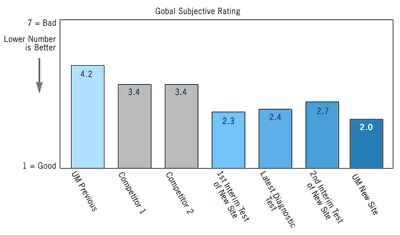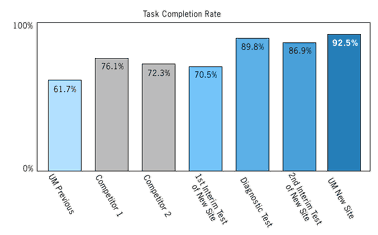

The University of Michigan Business School was in the midst of a major effort to brand itself as one of the top business schools in the country. As part of this initiative, they needed to redesign their web site to reflect their new image. The School wanted the new site to not only be visually attractive and functional, but also to offer simple and successful user experiences. The School brought the project to Diamond Bullet Design, due to our usability expertise and metrics-based user-centered design process.
Massive in scope, the University of Michigan Business School project entailed reorganizing a web site with more than 3,000 pages and 100 web applications, as well as integrating a public site with an intranet optimized for specific users. Our mission was to produce a new visual design and site architecture, making it more attractive and easier to use. To accomplish this, we applied our proven user-centered design process, which includes:
Strategy and User Needs AnalysisA crucial first step, we began by establishing a common understanding of the web site goals and requirements. With these goals in mind, we then reviewed the sites of other top business schools comparing overall image, functionality and task performance. We also performed baseline user testing of the top three competitor sites, in addition to testing the current business school site. This gave us benchmark data against which we could compare our progress and final results. During this initial phase, we also conducted focus group sessions with internal business school users to learn their current and future needs for the site.
Conceptual DesignOne of our design challenges was integrating the School's public site and intranet into one site. The School was interested in integrating these sites because valuable resources on the public site were often unknown to or not being accessed by intranet users. So, we assembled a multidisciplinary group of graphic designers, usability experts, and software engineers to brainstorm on interface and interaction approaches. This strategy enabled us to create the strongest, most usable solution as it impacted all elements of the website.
Our approach to the development of the conceptual design was task driven. We conducted task analyses for each user group, identifying important, frequent and complex tasks. In addition we created user profiles based on the different user groups. This enabled us to visualize the context in which the site would be used, identifying any potential problems or obstacles that might impact usability. Based on this information, we created a variety of design concepts for prototyping and testing.
Information ArchitectureThe previous Business School website grew organically from multiple independent groups. As a result, it was not consistent, had no overall architectural plan, and lacked orientation cues and navigational paradigms to help users locate information. Our baseline user testing indicated that people had significant difficulties finding information. As a result, we created a site architecture with an overall consistent structure and labeling scheme. Furthermore, our navigation system clearly indicates a user's current location and provides all of the relevant options in a clear and consistent manner.
PrototypingPrototyping and user testing are extremely effective methods for producing and improving information architecture and user interface design. Throughout this project, we tested nearly 200 people from our target audiences, obtaining crucial data that helped us ensure that our site would meet their needs. The testing also helped us analyze patterns in user errors, user feedback, and post-test interviews - extremely valuable information that dramatically impacts the site's usability.
Throughout this process, we used our custom built rapid-prototyping tool for viewing changes and performing user testing. This tool enabled us to modify information architecture, visual design and content independently from each other, and then quickly re-generate the site for further critique and user testing. This proved invaluable, making our user testing process extremely efficient. Our prototype sites were restructured over and over, continually refined to best meet user needs. And, because we were able to modify various areas of our prototype sites independently, progress in one testing area rarely became a bottleneck for testing other areas.
Production and DeploymentThe usability of the site was continually refined throughout our production process. A beta site released in October 2002, contained about half the content of the final site and an interim visual design. User feedback from this site was used to evaluate our visual design. Before final deployment, we continued user testing and putting final revisions on the new and vastly improved website.
The University of Michigan Business School web site redesign was completed in a relatively short time in relation to the scope of the project. Due to the project's size and high profile, the Business School needed a design process that would substantially reduce risk and guarantee the delivery of targeted project goals. As such, we were able to apply our proven usability methods and research techniques. This included setting baseline and targeted usability metrics for use as success criteria in relation to completion rates, task times, subjective task ratings and subjective overall ratings.
Based on Figures 1-2, our tests show we've made demonstrable improvements. The first column in each figure reflects the previous site before redesign. Next are two competitor sites, followed by our measurements in progressive tests. Our goal was to be better than the competitors on all four of these measures, which we've achieved.


Overall, our redesign of the University of Michigan Business School website accomplished:
For more detailed information, please read our white paper (pdf).